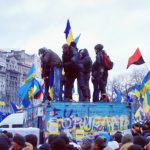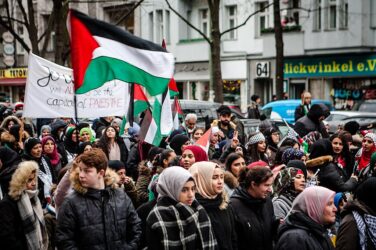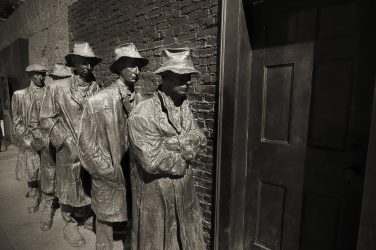Ioana Burtea reports from the recent protests in Bucharest where the controversy of cyanide-based mining has sparked fierce opposition. She also discusses the new role that independent media has found in informing and supporting young Romanian opposition.
I still wonder why I went to the protest on the September 1st. I had only attended such events as a reporter and what I had witnessed up to that point didn’t make me want to participate.
Protests in Romania usually meant a bunch of middle-aged people or pensioners brought to Bucharest in some political party or union’s bus in exchange for a bag of groceries each. They would occupy a public square for a couple of hour, shout apathetic slogans, a few would get drunk on cheap vodka and then they would clear out.
As for Roșia Montană – the area in Western Romania where the largest cyanide-based gold mining project is to happen unless MPs object to it – I never cared for it much. I knew of volunteers trying to raise awareness on the issue since I was in high school, but civil society initiatives always seemed feeble to me and unable to implicate a lot of people. In addition, the pro-environment protests I had covered were normally attended by a few hippies who used emotional arguments to sustain their cause. Besides, I was too uninformed to care – as were many of the protesters, too. Now, the movement attracts dozens of thousands and made headlines all across Europe.
The wake-up call
The 20-to-30-year-olds of Romania are infamously hard to bring together for a shared purpose.

Research by sociologist Dorin Bodea in 2011 revealed Romanians of working age are under the impression that their most important values are not shared by most of their nationals. To be precise, they don’t even think they have anything in common with each other. How can such a society ever reach a consensus?
The protests in Romania have been going on for three weeks now. The protesters want the government and parliament to reject the gold mining project at Roșia Montană, raising concerns about the legality of the process and the risks to the environment.
Far from dying down, these are the lengthiest and largest protests in the country since the students’ movement in 1990. It appears Roșia Montană managed to do what no greedy, corrupt and incompetent political leader has succeeded to do in almost 25 years of a shaky democracy: bring dozens of thousands into the streets, united. How did a small area in Western Romania with no tourism or infrastructure do this?Still, on September 1st, 3,000 people took the streets of Bucharest (while several thousand others protested elsewhere in Romania) and I was one of them. Like many, initially I was not there to save Roșia Montană.
Beyond curiosity and journalistic instinct, I was there because, for the first time, I would get to my whole circle of friends’ protest. I wanted to see how it would turn out and if people would actually come – and what type of people. A few hours later, at midnight, I was sitting on the ground in front of the emblematic Hotel Intercontinental in University Square, slamming a plastic water bottle on the concrete and shouting “United, we’ll save Roșia Montană!”
I looked around me: these were kids I knew from school or university, the clean, educated type whose parents taught them right from wrong. Some of their parents were there too, looking proud. They were determined. They weren’t going anywhere.
Roșia Montană – the beginnings
On the August 27th, the government assumed responsibility for passing a draft law allowing the Roșia Montană Gold Corporation (formerly known as Euro Gold Resources) to start the exploitation project and even expropriate locals against their will.
The controversial deal started 18 years ago when the off-shore company Gabriel Resources (GR) received a licence to exploit the Roșia Montană area. The mountains in the region are said to hold deposits of 314 tonnes of gold, and over 1,400 tons of silver were identified, making it the largest gold-silver deposit in the European Union.
The problem is Gabriel Resources received the licence through transfer from the state-owned company Minvest Deva, not through a public auction, as would have been legal. Furthermore, according to documents unburied by RISE Project (an independent community of Romanian journalists), a facade announcement stating the government was looking for a foreign partner to exploit precious metals in Roșia Montană was placed in a newspaper a day after the contract had already been signed with GR. After the deal was sealed, the state and the off-shore company formed Roșia Montană Cold Corporation (RMGC) – a mixed company in charge of implementing the project. The backroom deals and the amount of documents connected to Roșia Montană still classified as state secrets are reason enough to make anyone doubt the benefits of the project.
However, the controversy goes deeper. Frank Timis, a Romanian-born businessman from Australia who founded Gabriel Resources, was convicted several times for dealing heroin until one day he suddenly decided to invest in mining. The off-shore company was created with the precise purpose of mining in Romania, and had no previous experience in the field when it won the licence in 1995. One cannot help but wonder why the Romanian authorities chose to place its gold and silver, as well as four mountains and three villages, in the hands of Timis.
The reasons for concern don’t stop here. The perimeter to be exploited has more than doubled in the past years through additional documents to the original contract. The project also involves heavy use of cyanide, which even in small amounts is lethal to the environment. According to specialists, the mountains would be chopped and turned to dust which would contain gold particles. Afterwards, the dust would be placed in a reservoir and treated with cyanide, which would allow the gold to be separated and collected. The area would be left with a several kilometres wide crater and a permanent cyanide waste lake.
Asked to perform impact studies in the region, Environment Ministry experts wrote state-of-the-art reports justifying the wiping out of three villages and historical monuments. They wrote that, even though the area was “beautiful” and the archaeological discoveries “peculiar”, it also showed “redundancies” – as did the seven-kilometre-long “disfigured” Roman mining galleries which would “cost too much to renovate”.
The most solid arguments in favour of the project remained the creation of jobs in the area (Roșia Montană having an 80 per cent unemployment rate) and producing an impressive amount of money for the state. Journalists and economists quickly dismantled these arguments.
Win or lose?

Marcel Ionescu-Heroiu, a Regional Development PhD graduate from Cornell University and a World Bank employee, wrote a widely appreciated piece about the economical implications of the Roșia Montană project.
According to him, exploiting natural resources is actually hazardous for developing economies because it creates pressure on the national currency through fast money gains. In addition, economist theories insist that growth should be based on creative, innovative people and not a country’s natural resources.
For instance, mining does not generate human capital – leaving people vastly untrained and virtually unemployable after the end of the project – and hasn’t contributed to technological progress as much as other industries have. As far as creating 2,300 new jobs in the Roșia Montană area, this is also not true. Locals would only receive a few hundred of these jobs as cyanide mining is done on the surface, not in underground galleries and requires specialised workers.
In addition to the economical aspects, there is the matter of cyanide not being biodegradable. It is a much cheaper technology, but a far more dangerous one. The waste lake that would remain in Roșia Montană would have to be protected by a very strong dam – one that would last forever, to be more precise. RMGC said it would offer the state 250 million dollars for the dam’s maintenance, while the US Environmental Agency has estimated the cost at 2.6 billion dollars.
Should the dam break, the calamity would equal Chernobyl. What’s scarier is that Romania already has a precedent when it comes to cyanide spills. In 2000, a dam holding 100,000 cubic metres of cyanide-contaminated waters broke at Baia Mare and the spill affected nearby farmland and the Someș River. The waste spread all the way to Hungary and Serbia, killing most living things in its way. By comparison, the waste lake at Roșia Montană would be 2,500 times bigger than the one in Baia Mare.
So how much money is RMGC offering Romania to begin this extremely sensitive project? About 3.5 billion dollars. The problem is, this amount is a joke compared to the country’s need for investment. Looking at the capacity to invest as well, the situation is even worse: Romania’s absorption rate of free EU funds was only 26.2 per cent in June 2013, the lowest in the entire EU. Therefore, the money from the project, which would go straight to the Ministry of Economy, will likely have no real effect investment-wise. And even if RMGC offers more money for dam maintenance, even if an ecological disaster never happened, even if the money was properly invested by the state – it still wouldn’t be worth erasing four mountains, several historical places and three villages.
The faces of the protest
All of the above were forgotten or ignored by members of the government in August, when they decided it would be reasonable to rip Roșia Montană locals of their right to property. The country’s politicians also failed to anticipate the uprisings that would follow. For three weeks, protesters have been organising marches, sit-ins, happenings, bike demonstrations, human chains around the House of People and artistic activities. Largely ignored by the most viewed TV channels for the first few days, the protests have most faithfully been described by a new generation of independent journalistic communities such as Casa Jurnalistului, the RISE Project, as well as by freelance photographers, film-makers and activists. As a result, many protesters turned against the mainstream media, accusing it of receiving advertising money from RMGC.
I spoke to 25-year-old Vlad Ursulean of Casa Jurnalistului about these issues. “The mainstream media performed badly and people turned to other channels. They needed the information, we were in the right spot to offer it to them,” Vlad says. This journalist, who recently received acclaim for an investigation into shale gas and fracking, has no problem in siding with the protesters.
“The RMGC deal is, objectively speaking, a scam by the Romanian state, as dozens of journalistic investigations have shown over the years. I view these protests as a consequence of that work,” he concludes.

Vlad Petri is a freelance film-maker and photographer, and author of several popular short clips showing scenes from the protests. I asked him why he chose to go to the protests day after day. “I strongly believe that as a film-maker and photographer I have to document the times I live in,” he says. “I also believe that I have to inform people of what’s happening these days at the protests, as the mainstream media is concerned with other issues, in part due to the financial support they have from RMGC,” Petri further explains. He admits to being a supporter of the Roșia Montană cause as well. “I have to say that I support the people on the streets who protest against the mining project, but I try to present things from different angles. I don’t want a fabricated image; I want to be as close as possible to what I see on the streets with a naked eye. A balanced view, with a subjective touch,” the film-maker says.
This is certainly an expression of a new form of journalism that has become popular with the Romanian youth. According to Paul Radu of RISE Project, these are protesters who can change the face of Romanian journalism. A blog post by Paul Radu claims this phenomenon was made possible by the “lack of professionalism of journalists who, at one point, stopped learning, became self-sufficient, dependent on sources connected to politicians or media owners”. In contrast, the new generation of independent reporters has the internet and social media as means of distributing information; they are transparent about their investigation techniques and are open to collaboration with others like them. RISE Project calls this “evidence-based activism”.
New journalism vs. traditional media
Without doubt, these newcomers are a welcome and necessary change to the media landscape of Romania. However, protesters’ criticism towards the mainstream media and their accusations that established media outlets ignored them are not entirely called for.
In the first days of the protests, TV crews failed to show up and cover the events.
Their biggest complaints were that, in the first days of the protests, TV crews failed to show up and cover the events, and audience-pleasers PRO TV, Antena 1, Antena 3 or Kanal D broadcast no reports about them. This shows a weak understanding of what the media consists of. While the most-viewed TV channels have indeed failed to cover the protests, the majority of traditional outlets did so constantly – Digi24 news channel, Realitatea TV, Dilema Veche weekly, Ziarul Financiar daily, Europa FM and RFI radio stations, as well as anchor Moise Guran from the public television station spoke, and wrote both about the protesters and the new generation of journalists emerging into the spotlight. They just weren’t what the protesters expected. People mistakenly associate the entirety of the mainstream media with a handful of TV channels that may or may not be politically tainted.
However, it’s not just about which outlets covered the protests; it’s also about how the mainstream media did so. The recent events applied perfectly to the new generation of journalists (being a movement of the young and the interconnected), while Casa Jurnalistului, RISE Project and others like them are still niche.
They impress audiences with surprising discoveries (like the documents published by RISE), in-depth reporting, their passionate tone and the warmth and familiarity of their depictions. They aren’t constrained by deadlines, 24-hour news cycles, editors, word limits or news genre. And yes, they aren’t constrained by politics or advertising. This alone is more than enough to lead to a change in audience habits and preferences. The merits of these young reporters and the value of their work are obvious; demonising the mainstream media and generalising aren’t necessary. Now it’s the public’s turn to choose what information it wants and how it wants it packaged.
“Hipsters” and their demands
One of the biggest criticisms received by the protesters in Romania is the fact that they have diverse demands – a certain lack of focus, according to critics. They voiced their discontent about the country’s politicians, about corruption, the lack of government transparency, capitalism, and the media, some even against euthanising stray dogs. As a young woman interviewed by Casa Jurnalistului said, the protest isn’t entirely about saving Roșia Montană – this was just what the people needed to come out into the streets. Vlad Petri believes this diversity is a good thing. “I think we all have to discuss the important issues taking place in our society and think about strategies and solutions for the future,” he explains.

Comparisons with Taksim Square or Tahrir Square are not an overreaction. It is merely a consequence of the world we now live in. From Occupy and Indignados, to Istanbul and Cairo, we see young people living and thinking in a larger context. Their universes are vaster than those of their parents and grandparents. They are more connected to the outside world and they inspire each other. Writer Elif Shafak once said: “We are born into a certain family, nation or class. But if we have no connection whatsoever with the worlds beyond the one we take for granted then we too run the risk of drying up inside.” The younger generations know and understand this.
As for the original purpose of the demonstrations, it is yet to be seen if the mining project will be prevented from happening. Roșia Montană has surely drawn some reputable protectors. Even if RMGC gets its way, the experience the people have been sharing for the past three weeks will surely not allow them to dry up inside or stop trying. And who know, perhaps one day not too far along the road, they will succeed in bringing real change to their country.
This text is published as part of an ongoing cross-publication partnership with New Eastern Europe magazine. The text also appeared in our bi-monthly column ‘Transnational Perspectives’.
Cover photo: Ioana Burtea








